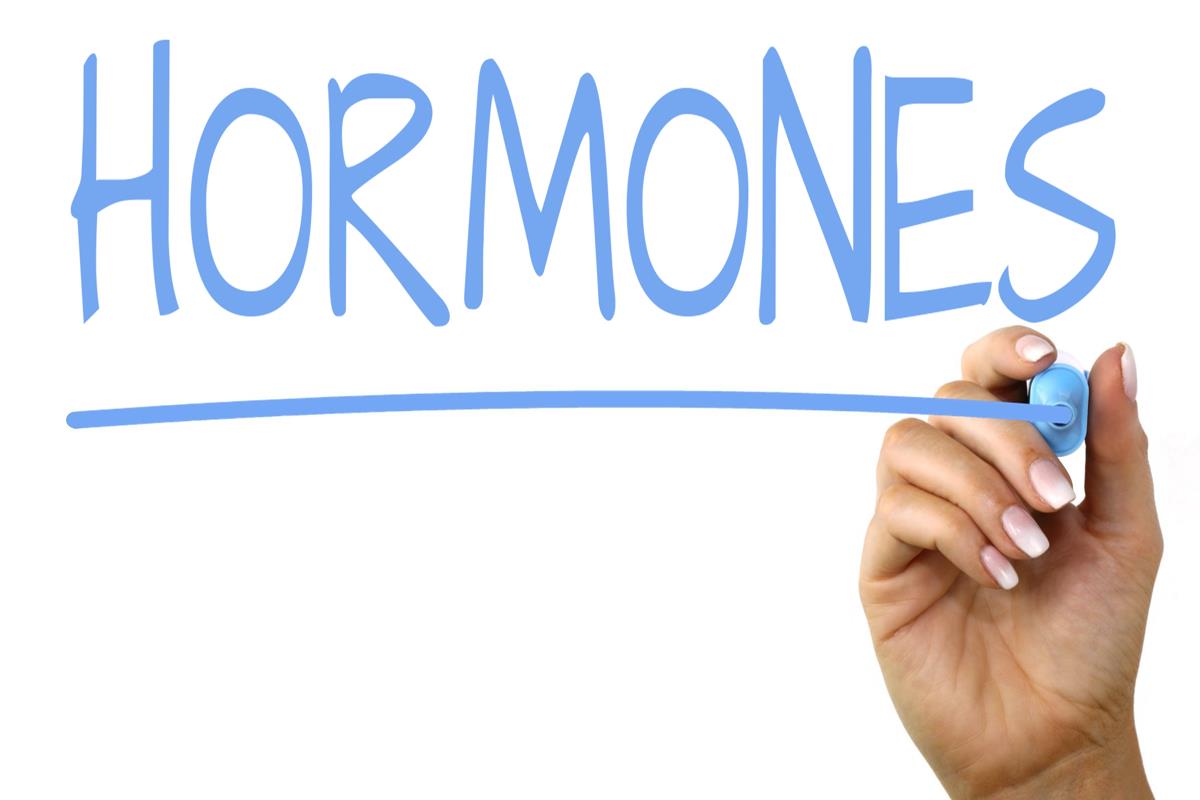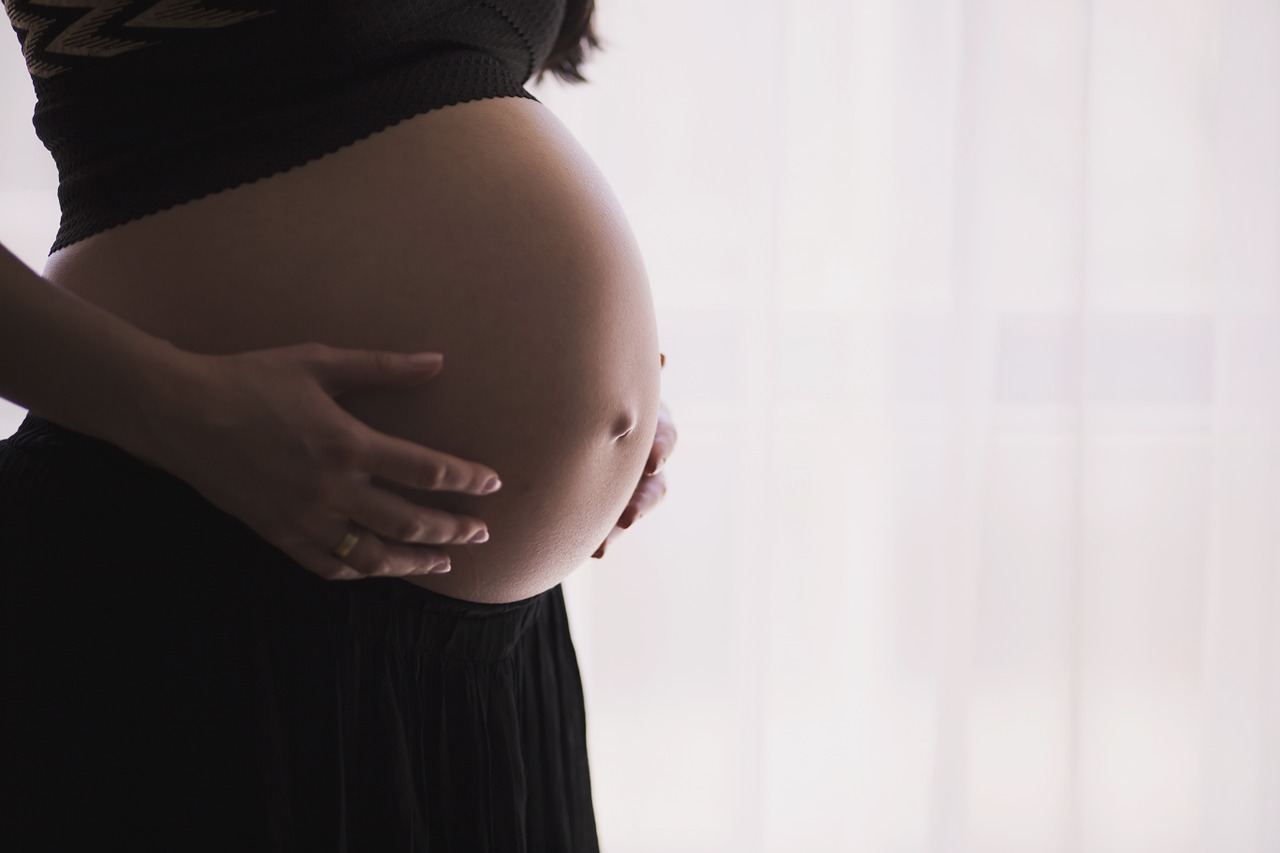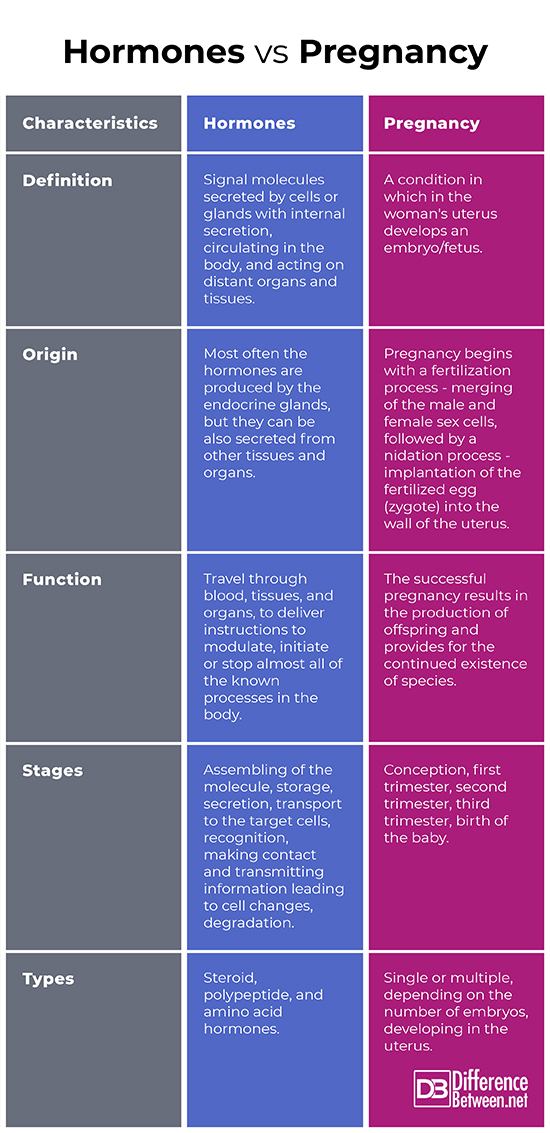Difference Between Hormones and Pregnancy
What is Hormones?
Hormones are signal molecules secreted by cells or glands with internal secretion, circulating in the body, and acting on distant organs and tissues.
The hormones travel through blood, tissues, and organs, to deliver instructions to modulate, initiate or stop almost all of the known processes in the body. The hormones regulate the metabolism, growth, development, immune system, mood, sexual functions, behavior, etc.

Acting as signal molecules, hormones bind to specific receptor proteins in the target cell. The binding itself is often enough to change the behavior of the target cell.
Any hormone associated with a specific receptor results in a cell-specific response. The response may be:
- Rapid non-genetic response;
- Slower genetic response – the receptors affect gene transcription and increase or decrease the release of given proteins.
Most often the hormones are produced by the endocrine glands, but they can be also secreted from other tissues and organs.
The secretion of hormones is highly dependent on the body’s condition. For example, the blood sugar levels affect the production of insulin; the concentration of potassium ions in blood plasma affects the synthesis of parathyroid hormone, etc.
The hormones can be:
- Steroid hormones;
- Polypeptide hormones;
- Amino acid hormones.
Hormones may circulate in the blood to reach distant target cells or remain where they are secreted and act on the nearby cells. There is a specific type of hormones, called autocrine hormones, which act on the cells which have secreted them.
The life of each hormone consists of six stages:
1. Assembling of the molecule of the hormone;
2. Storage and secretion;
3. Transport to target cells;
4. Recognition of the hormone from the cell membrane and/or receptors;
5. Making contact and transmitting information leading to cell changes;
6. Degradation of the hormone.

What is Pregnancy?
Pregnancy is a condition in which in the woman’s uterus develops an embryo/fetus. The term “embryo” is used during the first 8 gestation weeks and the term “fetus” – after the 9th gestation week.
Pregnancy begins with a fertilization process – merging of the male and female sex cells, followed by a nidation process – implantation of the fertilized egg (zygote) into the wall of the uterus. Pregnancy ends with the birth of the baby.
Different symptoms of pregnancy occur in the woman’s body, primarily under the action of elevated levels of hormones. In each pregnant woman, the symptoms of early pregnancy are different, but there are some common pregnancy symptoms:
- Late/absent menstruation;
- Nausea and vomiting;
- Feeling of dizziness, weakness, and fatigue, resulting from changes in the blood flow and hormonal fluctuations;
- Tension and changes in the breasts, resulting from the hormonal specifics of the early pregnancy;
- Spasms, resulting from the gradual stretching of the uterus;
- Vaginal bleeding, weaker than the menstruation and lasting for 3-4 days (in about 25% of pregnant women);
- Darkening of the nipples, resulting from the accumulation of melanin in the melanocytes;
- Mood changes, resulting from hormonal changes;
- Feeling of abdominal swelling, resulting from a delayed function of the digestive system during pregnancy;
- More frequent urination, resulting from an increase in the blood flow, passing through the kidneys and from the pressure caused by the growing baby to the bladder ;
- Changes in appetite and food preferences, etc.
Pregnancy may be single or multiple, depending on the number of embryos, developing in the uterus of the pregnant woman. In multiple pregnancy, the embryos may have originated from one fertilized egg or from different ones.
Birth usually occurs about 38 weeks after conception, or approximately 40 weeks after the beginning of the last menstruation.
Pregnancy is typically divided into three trimesters.
- First trimester – weeks 1 to 12.
- Second trimester- weeks 13 to 28.
- Third trimester – weeks 29 to 40.
Difference Between Hormones verses Pregnancy
-
Definition
Hormones: Hormones are signal molecules secreted by cells or glands with internal secretion, circulating in the body, and acting on distant organs and tissues.
Pregnancy: Pregnancy is a condition in which in the woman’s uterus develops an embryo/fetus.
-
Origin
Hormones: Most often the hormones are produced by the endocrine glands, but they can be also secreted from other tissues and organs.
Pregnancy: Pregnancy begins with a fertilization process – merging of the male and female sex cells, followed by a nidation process – implantation of the fertilized egg (zygote) into the wall of the uterus.
-
Function
Hormones: The hormones travel through blood, tissues, and organs, to deliver instructions to modulate, initiate or stop almost all of the known processes in the body. They regulate the metabolism, growth, development, immune system, mood, sexual functions, behavior, etc.
Pregnancy: The successful pregnancy results in the production of offspring and provides for the continued existence of species.
-
Stages
Hormones: The life of each hormone consists of: assembling of the molecule, storage, secretion, transport to the target cells, recognition, making contact and transmitting information leading to cell changes, degradation.
Pregnancy: Pregnancy is typically divided into three trimesters: the first trimester includes weeks 1 to 12, the second trimester- weeks 13 to 28, and the third trimester – weeks 29 to 40. It begins with the conception and ends with the birth of the baby.
-
Types
Hormones: The hormones can be steroid, polypeptide, and amino acid hormones.
Pregnancy: Pregnancy may be single or multiple, depending on the number of embryos, developing in the uterus.
Hormones vs Pregnancy

Summary of Hormones verses Pregnancy:
- Hormones are signal molecules secreted by cells or glands with internal secretion, circulating in the body, and acting on distant organs and tissues.
- Pregnancy is a condition in which in the woman’s uterus develops an embryo/fetus.
- Most often the hormones are produced by the endocrine glands, but they can be also secreted from other tissues and organs. Pregnancy begins with a fertilization process – merging of the male and female sex cells, followed by a nidation process – implantation of the fertilized egg (zygote) into the wall of the uterus.
- The hormones travel through blood, tissues, and organs, to deliver instructions to modulate, initiate or stop almost all of the known processes in the body. The successful pregnancy results in the production of offspring and provides for the continued existence of species.
- The life of each hormone consists of: assembling of the molecule, storage, secretion, transport to the target cells, recognition, making contact and transmitting information leading to cell changes, degradation. Pregnancy begins with the conception and ends with the birth of the baby. It is typically divided into three trimesters.
- The hormones can be steroid, polypeptide, and amino acid hormones. Pregnancy may be single or multiple, depending on the number of embryos, developing in the uterus.
- Difference Between Gallstones and Cholecystitis - September 5, 2021
- Difference Between Constipation and Cramping - August 4, 2021
- Difference Between Whole Genome Sequencing and Microarray - May 6, 2021
Search DifferenceBetween.net :
Leave a Response
References :
[0]Bernhard, K., W. Rossmanith. Hormones and the Endocrine System. Textbook of Endocrinology. Basel: Springer International Publishing. 2016. Print.
[1]Hinson, J., P. Raven, S. Chew. The Endocrine System: Systems of the Body Series 2nd Edition. London: Churchill Livingstone. 2010. Print.
[2]Hoffman, B., J. Schorge, K. Bradshaw, L. Halvorson, J. Schaffer, M. Corton. Williams Gynecology, Third Edition. New York: McGrow-Hill 2016. Print.
[3]Image credit: https://pixabay.com/en/pregnant-mother-body-pregnant-woman-1245703/
[4]Image credit: http://www.thebluediamondgallery.com/handwriting/images/hormones.jpg
